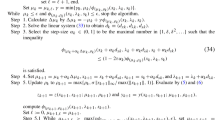Abstract
It has been shown [8] that numerous interior-point algorithms for linear programming (LP) generate solution sequences that converge to strict complementarity solutions, or interior solutions on the optimal face. In this note we further establish a theoretical base for Gay's test (Gay, 1989) to identify the optimal face, and develop a new termination procedure to obtain an exact solution on the optimal face. We also report some numerical results for solving a set of LP test problems, each of which has a highly degenerate and unbounded optimal face.
Similar content being viewed by others
References
I. Adler and R.C. Monteiro, “A geometric view of parametric linear programming,” manuscript, Department of IEOR, University of California (Berkeley, CA, 1989).
K.M. Anstreicher, “Dual ellipsoids and degeneracy in the projective algorithm for linear programming,”Contemporary Mathematics 114 (1991) 141–150.
G.B. Dantzig,Linear Programming and Extensions (Princeton University Press, Princeton, NJ, 1963).
D.M. Gay, “Stopping tests that compute optimal solutions for interior-point linear programming algorithms,” Numerical Analysis Manuscript 89-11, AT&T Bell Laboratories (Murray Hill, NJ, 1989).
P.E. Gill, W. Murray, M.A. Saunders, J.A. Tomlin and M.H. Wright, “On projected Newton barrier methods for linear programming and an equivalence to Karmarkar's projective method,”Mathematical Programming 36 (1986) 183–209.
A.J. Goldman and A.W. Tucker, “Theory of linear programming,” in: H.W. Kuhn and A.W. Tucker, eds.,Linear Inequalities and Related Systems (Princeton University Press, Princeton, NJ, 1956) pp. 53–97.
C.C. Gonzaga, “An algorithm for solving linear programming problems in O(n 3 L) operations,” in: N. Megiddo, ed.,Progress in Mathematical Programming — Interior Point and Related Methods (Springer, New York, 1989) pp. 1–28.
O. Güler and Y. Ye, “Convergence behavior of some interior-point algorithms,” to appear in:Mathematical Programming (1993).
N. Karmarkar, Talk atThe 1985 Asilomar Linear Programming Workshop (Asilomar, CA, 1985).
N. Karmarkar, “A new polynomial-time algorithm for linear programming,”Combinatorica 4 (1984) 373–395.
M. Kojima, “Determining basic variables of optimal solution in Karmarkar's new LP algorithms,”Algorithmica 1 (1986) 499–515.
M. Kojima, S. Mizuno and A. Yoshise, “An\(O(\sqrt n L)\) iteration potential reduction algorithm for linear complementarity problems,”Mathematical Programming 50 (1991) 331–342.
M. Kojima, S. Mizuno and A. Yoshise, “A polynomial-time algorithm for a class of linear complementarity problems,”Mathematical Programming 44 (1989) 1–26.
R.E. Marsten, M.J. Saltzman, D.F. Shanno, G.S. Pierce and J.F. Ballintijn, “Implementation of a dual affine interior point algorithm for linear programming,” Working Paper CMI-WPS-88-06, University of Arizona (Tucson, AZ, 1988).
K.A. McShane, C.L. Monma and D.F. Shanno, “An implementation of a primal-dual interior point method for linear programming,”ORSA Journal on Computing 1 (1989) 70–83.
N. Megiddo, “On finding primal- and dual-optimal bases,”ORSA Journal on Computing 3 (1991) 63–65.
S. Mehrotra, “On finding a vertex solution using interior point methods,” TR89-22R, Department of IE/MS, Northwestern University (Evanston, IL, 1989).
S. Mehrotra and Y. Ye, “On finding the optimal face of linear programs,” TR91-10, Department of IE/MS, Northwestern University (Evanston, IL., 1991).
S. Mizuno, M. J. Todd and Y. Ye, “On adaptive-step primal-dual interior-point algorithms for linear programming,” to appear in:Mathematics of Operations Research (1992).
R.C. Monteiro and I. Adler, “Interior path following primal—dual algorithms. Part I: Linear programming,”Mathematical Programming 44 (1989) 27–41.
Yu.E. Nesterov and A.S. Nemirovsky,Self Concordant Functions and Polynomial Time Methods for Smooth Convex Programming (Moscow, USSR, 1989).
J. Renegar, “A polynomial-time algorithm, based on Newton's method, for linear programming,”Mathematical Programming 40 (1988) 59–93.
A. Schrijver,Theory of Linear and Integer Programming (Wiley, New York, 1986).
G. Sonnevend, “An ‘analytic center’ for polyhedrons and new classes of global algorithms for linear (smooth, convex) programming,”Proceedings of the 12th IFIP Conference on System Modeling and Optimization (Budapest, 1985).
R.A. Tapia and Y. Zhang, “A fast optimal basis identification technique for interior point linear programming methods,” Report TR89-1, Rice University (Houston, TX, 1989).
M.J. Todd, “The effects of degeneracy and null and unbounded variables on variants on Karmarkar's linear programming algorithm,” in: T.F. Coleman and Y. Li, eds.,Large-Scale Numerical Optimization (SIAM, Philadelphia, PA, 1991) pp. 81–91.
M.J. Todd, “Improved bounds and containing ellipsoids in Karmarkar's linear programming algorithm,”Mathematics of Operations Research 13 (1988) 650–659.
P.M. Vaidya, “An algorithm for linear programming which requires O(((m+n)n 2+(m+n) 1.5 n)L) arithmetic operations,”Mathematical Programming 47 (1990) 175–202.
Y. Ye, “A ‘build-down’ scheme for linear programming,”Mathematical Programming 46 (1990) 61–72.
Y. Ye, K.O. Kortanek, J.A. Kaliski and S. Huang, “Near-boundary behavior of primal—dual potential reduction algorithms for linear programming,” to appear in:Mathematical Programming (1993).
Author information
Authors and Affiliations
Additional information
Research supported in part by NSF Grant DDM-8922636, The Iowa Business School Summer Grant, and the Interdisciplinary Research Grant of the University of Iowa Center for Advanced Studies.
Rights and permissions
About this article
Cite this article
Ye, Y. On the finite convergence of interior-point algorithms for linear programming. Mathematical Programming 57, 325–335 (1992). https://doi.org/10.1007/BF01581087
Received:
Revised:
Issue Date:
DOI: https://doi.org/10.1007/BF01581087



